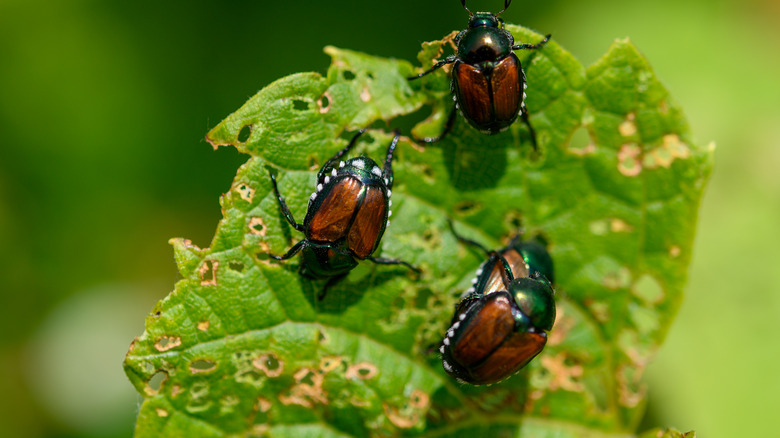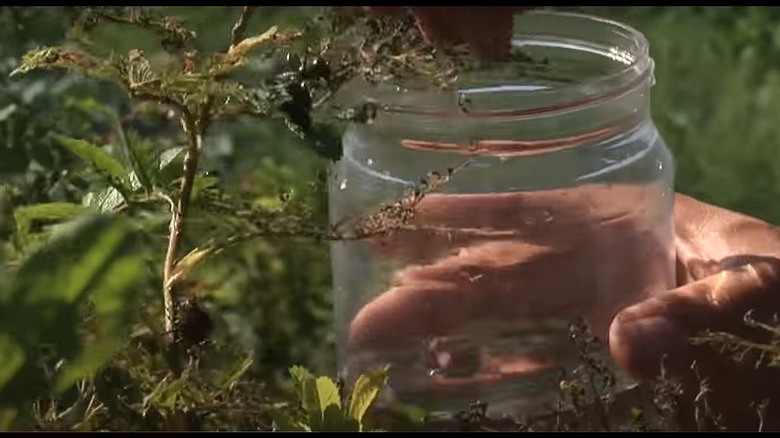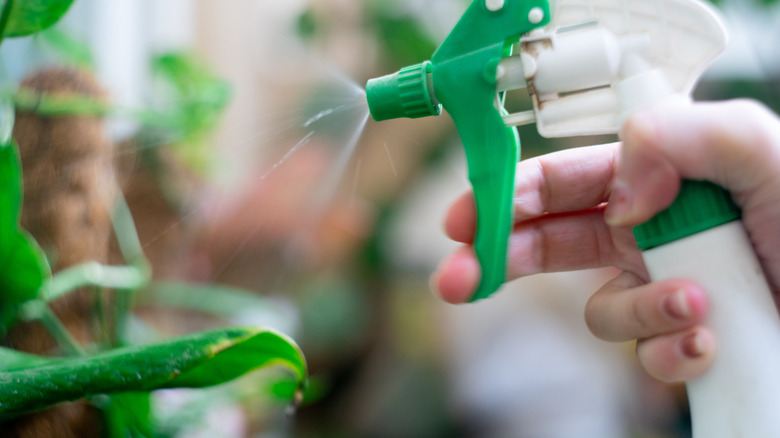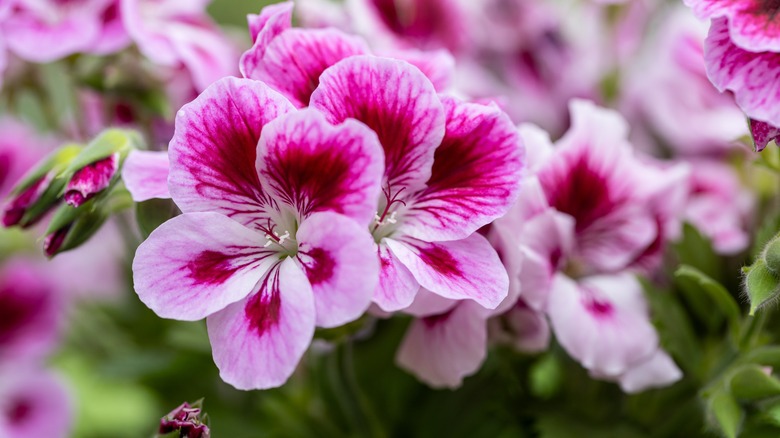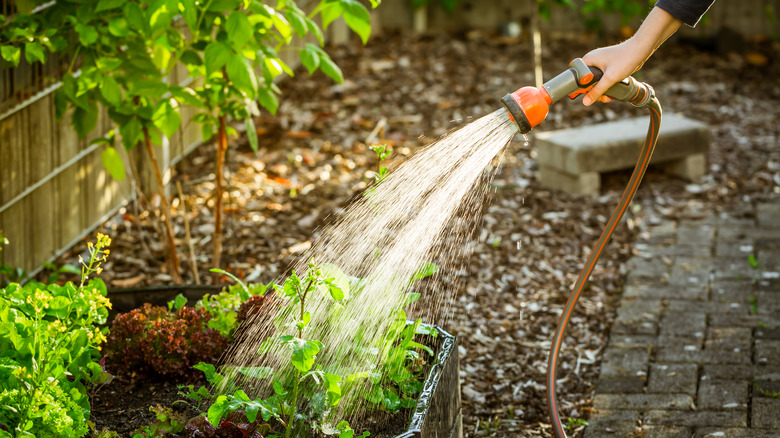The Top 5 DIY Solutions For Keeping Pesky Japanese Beetles Out Of Your Garden
You aren't the lone anticipator of spring; the Japanese beetle grubs look forward to it, too. Around this time, these little ones are done with the roots underground and finally break the (soil) ceiling to move their base above the substrate. Once they move up and assume their winged forms, your plants know no peace, and the same goes for you. Luckily, you don't have to depend on toxic chemicals to get rid of the menace; there's plenty you can do on your own. The easiest way is to pick the feeders off and dunk them in soapy water. But if the icky feeling comes on too strong, use neem oil—although it'll test your nose. Some plant-derived essential oils are beetles' doom, too.
These metallic copperish-green creatures are true food connoisseurs, munching on anything that falls in their sight, including grapes, roses, marigolds, birch, and basil. Although they don't kill the plants outright, the sight of chewed-through, lace-like leaves without any shred of green between the veins will surely cause heartburn. Counterintuitively, you can keep the Japanese beetles out by planting flowers like geraniums that act like sweet poison. But if you aren't in the mood for labor, neglect your yard and underwater it to prevent egg hatching.
Pick 'n' drop the beetles in soapy water
Japanese beetles are easy to spot, thanks to their brown-winged bodies covered in white hairy clumps. Build a routine to remove the beetles physically. Put on nitrile gloves if touching the invasive species makes you uncomfortable. Also, carry a water jug with a dash of detergent soap mixed in. While soap isn't essential, it reduces the water's surface tension, making it easier to trap and submerge the pesky insects.
Lightly tap the stems of the plant they're infesting with the jug underneath so the beetles fall directly into the soapy solution. You can cover your plant with a drop cloth to shake and drop off the insects in the jug. Maintain the routine for six to eight weeks until the adults stop feeding actively. Alternatively, suck up the beetles with a small, handheld home or car vacuum and empty the contents in soapy water. While the process may seem laborious, it's quite effective. The reason? Beetle-eaten foliage emits pheromones that attract their brethren, ballooning the problem. But once you start removing the voracious feeders, it breaks the cycle, yielding long-term benefits. For the best results, pluck out the beetles in the early morning or late evening when they feel listless and are unlikely to fly out far.
Use neem oil to control the population
Unlike soapy water, neem oil—a naturally occurring yellowish-brown neem tree sap—isn't a contact killer. This means it can't wipe out the Japanese beetle population merely by touch. What it does instead is target the adults who, after a round of feeding, are game for procreation. In one season, female beetles can lay over 60 eggs, which hatch in under two weeks, causing a population explosion. Neem oil offsets this by inhibiting their ability to lay eggs.
Deploy the strategy by drenching the infested foliage in cold-pressed neem oil. As neem contains azadirachtin, feeding on the sprayed foliage causes the adult insects to lose their appetites, reducing plant damage. Moreover, they're forced to evacuate the area, as they can't stand its foul smell. The biggest advantage comes from the chemical being passed to the eggs, preventing the larvae from pupating into adults. So, apply the neem oil before the beetles begin mating. Don't forget to reapply after it rains. That being said, neem oil isn't a selective killer and shouldn't be used around aquatic life to avoid harm. Also, don't make the mistake of using garden center-sold clarified neem variants. Lacking azadirachtin, their efficacy is significantly diminished, reducing them to mere vegetable oils that suffocate beetles when submerged for too long.
Spray essential oils to repel beetles
Another handy way to rid your garden of Japanese beetles is to use their olfactory senses against them. In 2009, the USDA published results from its various trials investigating the effects of essential oils, especially peppermint and wintergreen, on these troublesome breeders. These plant-derived emollients drove the beetles out even when sprayed next to an attractant, specifically targeting their hoard.
So, how do you use them to protect your precious roses, hydrangeas, and other victimized ilk? Well, the study didn't share its deets, but Pest Pointers recommends a recipe you can customize depending on the oil. Grab a spray bottle and pour in 1 cup of water. Next, add 10 to 15 drops of the essential oil using the dropper. Mix well, and voila, your potent weapon is ready. Spray the solution liberally where the infestation is particularly severe, and watch the fliers move their buffet away from your garden. But if it fails to pack a punch, combine ginger and wintergreen oils for stronger results.
While there's plenty of anecdotal evidence floating around on the efficacy of cedar oils, the USDA study cautions that the effects aren't particularly strong to warrant its classification as a repellent. However, they work on mild infestations, provided you use Eastern red cedar oil. Juniperberry and oregano oils are other viable options that yield similar results.
Plant geraniums to paralyze the beetles
Even though Japanese beetles aren't particularly choosy with their food, zonal geraniums (Pelargonium zonale) have their heart. But nature has its way of balancing things, as the pests become boggled after consuming their favorite food. Agricultural Research Science, a USDA research agency, backs these claims, too. It works because the bugs become paralyzed after dusting off all the tropical petals.
The initial signs of poisoning show up in under 30 minutes, with the pests rolling over to lie on their backs. What follows is a deliberate convulsing of their antennae and legs, ultimately leading to a full-blown paralysis that lasts several hours. Though the beetles recover from their stunned state within a day, not all are lucky. This is because the brief period of immobilization leaves them vulnerable to other garden predators, including birds, that love gorging on them. But there's more to it. As geraniums have a short stature, the grubs monopolize them first after moving on from root-feeding. This helps prepare for the future, as the congregation of grubs indicates how severe the plague will be. There are other pest-resistant varieties, such as chrysanthemum, forsythia, magnolia, oak, and rhododendron, that you can plant to repel Japanese beetles naturally. Avoid interplanting garlic, chives, or catnips, as they don't bother these beetle varieties.
Modify your gardening habits
Sometimes, rather than using various home remedies, all you need to get a grip on the Japanese beetle problem is a little change-up in how you treat your garden. For instance, lowering your irrigation frequency during the adult beetle's peak feeding time can spare you a lot of grief. With their stomachs full, female beetles get ready to mate and lay their eggs in well-watered, grassy turfs. Water is the driving factor here, as eggs dry out without it. So, naturally, if the eggs don't hatch, you've got no grubs to deal with. Similarly, the existing grubs won't mature into adults and wreak havoc the next season.
While reducing irrigation in peak summer—during July and August—does kill plenty of beetle eggs, it can stress your plants if not done right. As plants face enough trouble dealing with high temperatures, they must get their water dosage for healthy growth. To achieve both goals, consider deep watering your garden irregularly. This stimulates deep rooting, raising their drought tolerance while creating an environment that is unconducive for beetles' eggs. But if some grubs have already caused root injuries, increase your watering during August and September to boost regrowth. Also, mow the turf with an aerifier with ½-inch wide tines to eliminate eggs and build tolerance.
